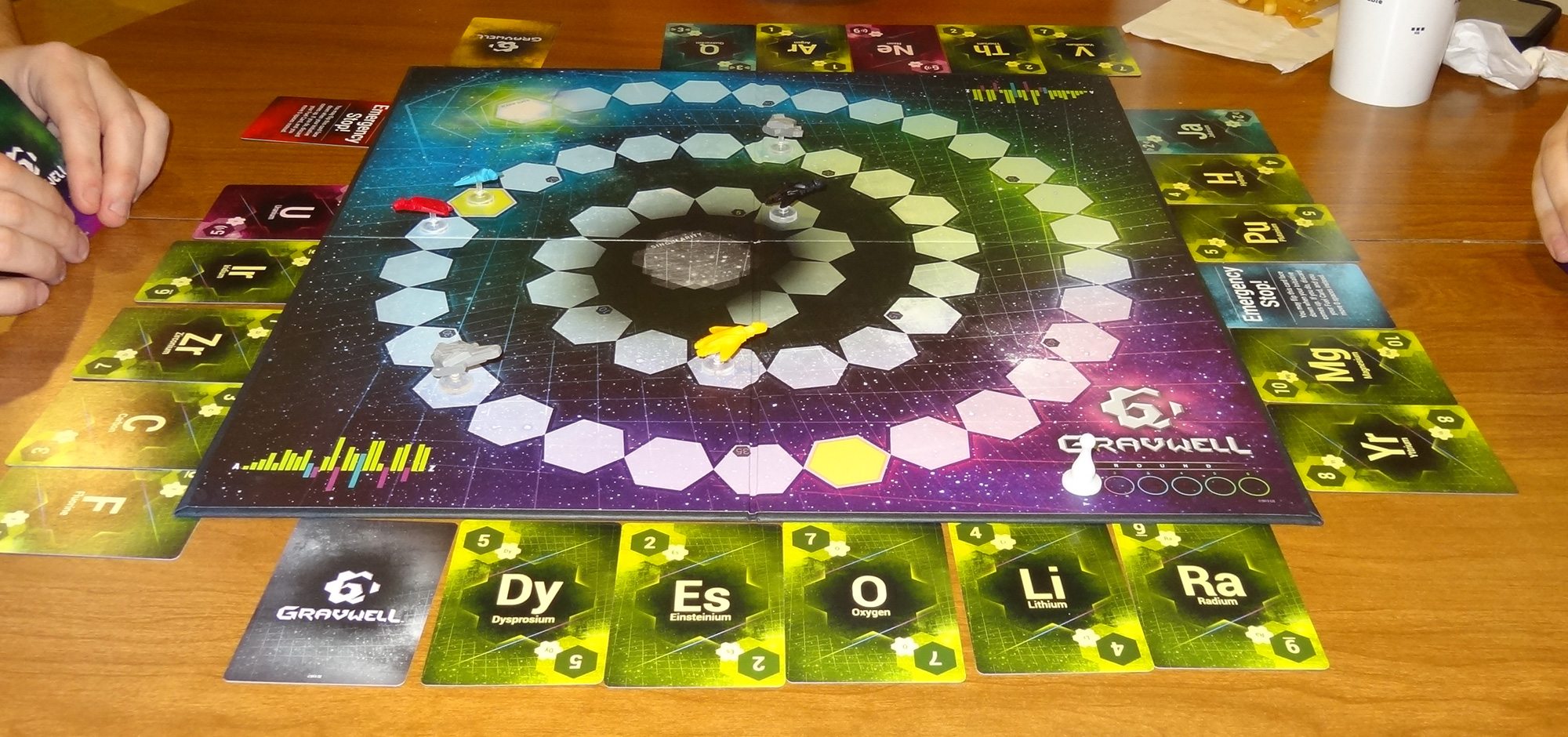
One of Cryptozoic’s sold-out hits of Gen Con this year was Gravwell: Escape From the 9th Dimension, but I didn’t get a chance to play it until just recently. It’s a deceptively simple game that’ll leave your mind spinning (and wanting more). The key to the whole thing is this mechanic: your movement is based on whatever ship is closest to you at the time, keeping in mind that the closet ship may be behind you.
The Basics
Gravwell is for 1-4 players, takes about half an hour to play, and retails for $35. (It’s showing up as out of stock in many places for now, but the second printing should start arriving at stores soon.) The box says it’s for ages 15 and up, but younger players could catch on pretty easily.
The Story
You and a few other ships have somehow survived passing through a black hole, and find yourself in a new dimension where physics has been warped. Bear with me. You collect basic elements from asteroids which fuel your ships just enough to provide a little bit of thrust—but generally only toward the nearest object. Use your elements in the right order so you can slingshot yourself past the other ships (including a few dead hulks) and through the Warp Gate to escape the Gravwell.
Components
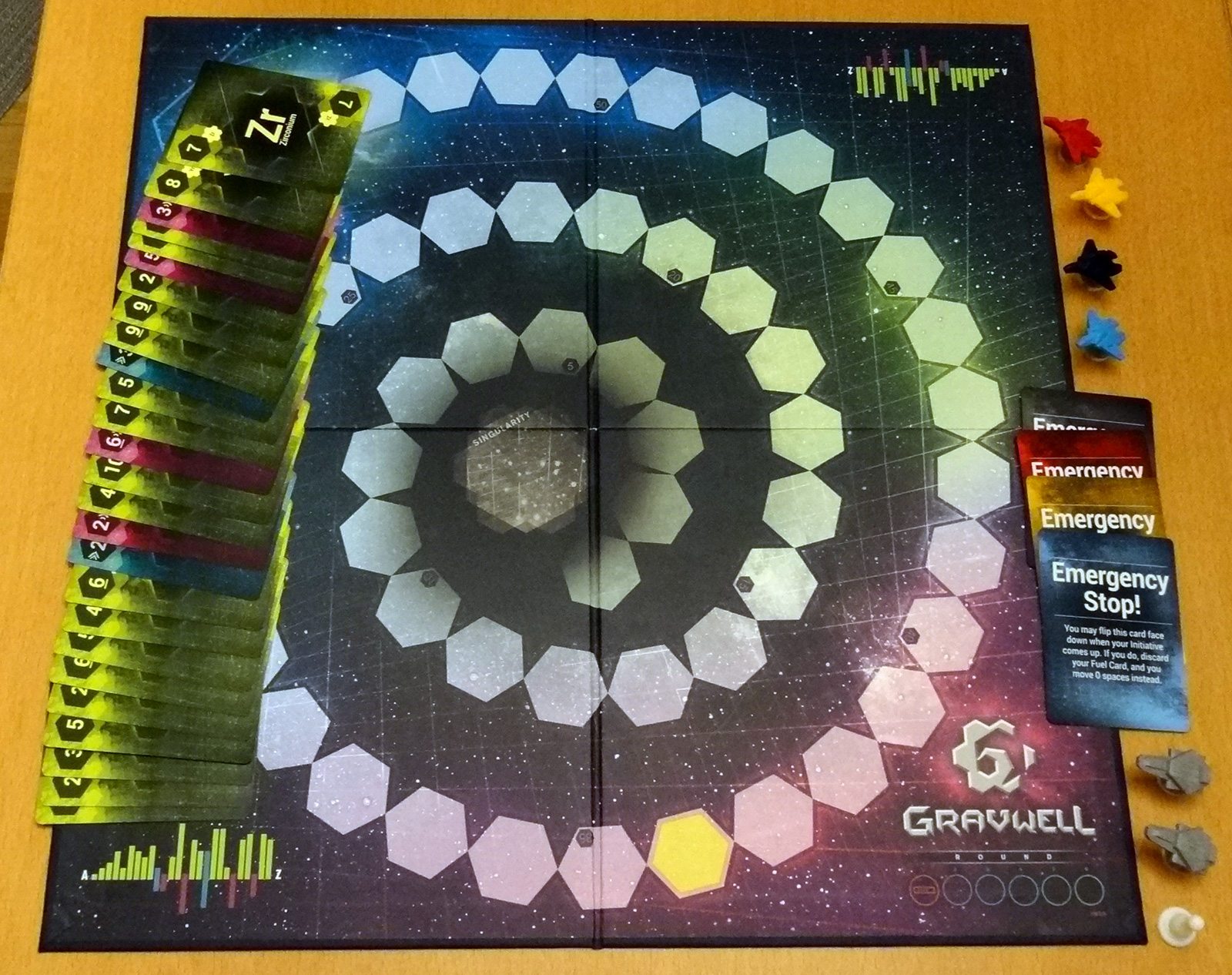
Here’s what comes in the box:
- Game board
- 4 Emergency Stop cards (1 per color)
- 4 player ship tokens (1 per color)
- 2 derelict ship tokens (gray)
- 1 round marker
- 26 Fuel Cards
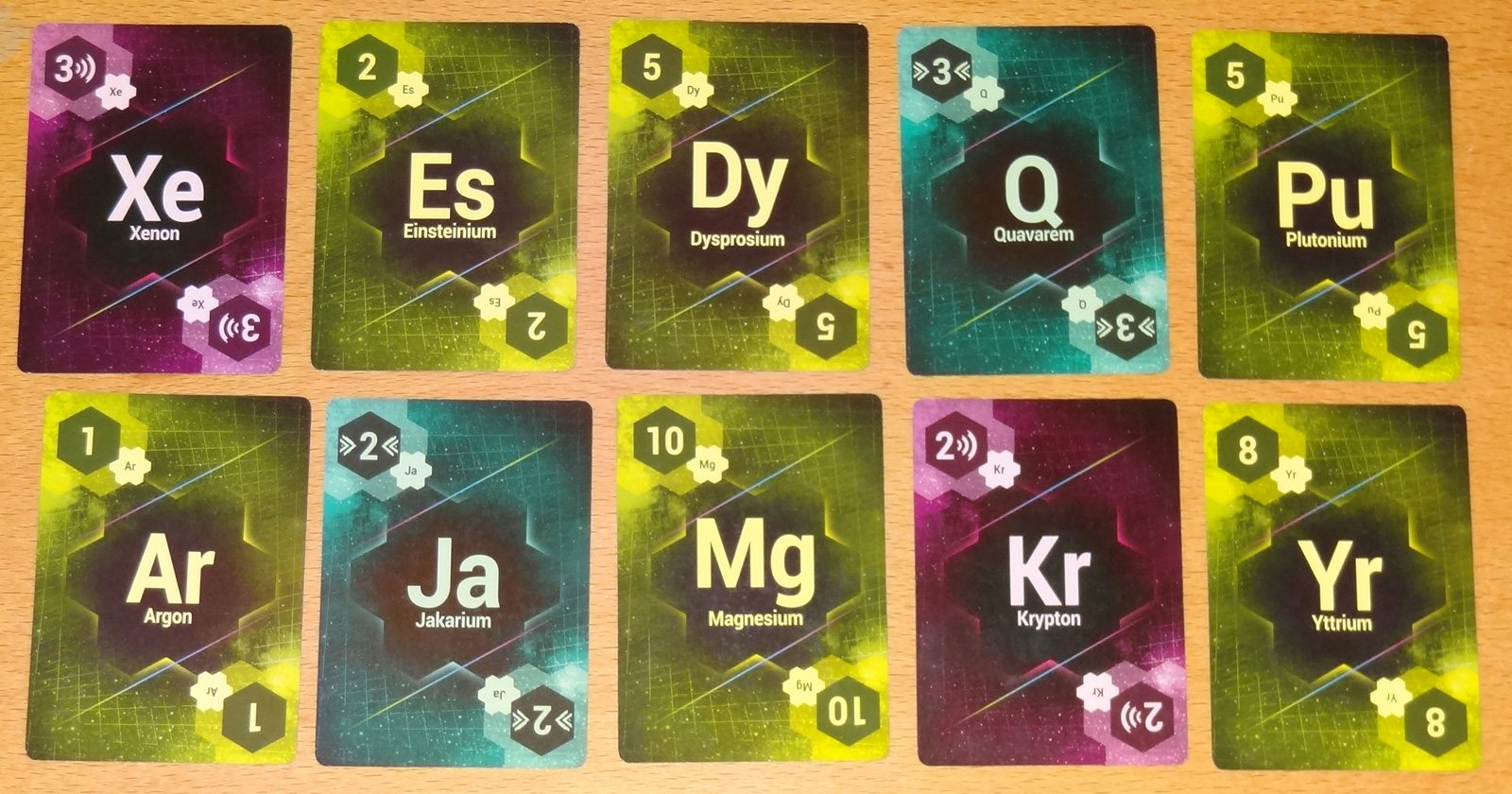
The Fuel Cards have letters from A to Z, each representing an element (including some bizarrely-named pretend elements). Each also has a number, showing how many spaces that element will move your ship. Finally, most of the cards are green for regular movement, but there are also a few purple Repulsor cards and blue Tractor Beam cards. The cards are simple and easy to read at a glance, with just enough graphics to keep them from being boring to look at.
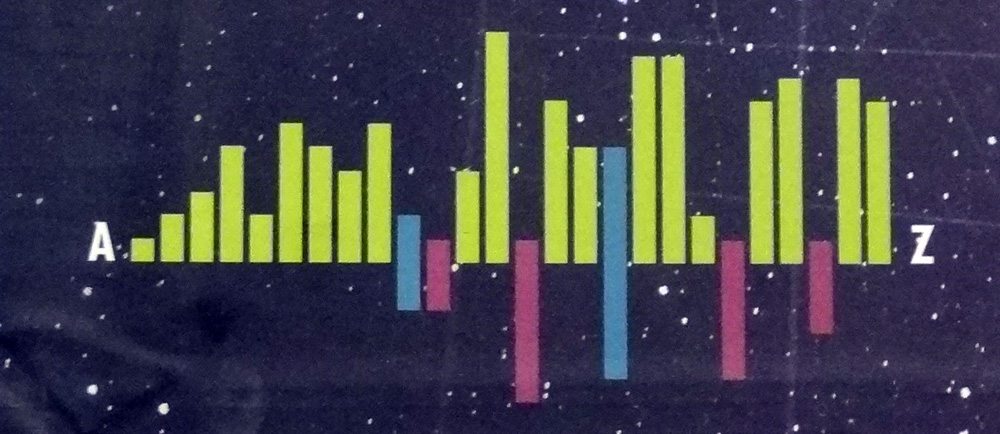
As you can see from the photos, the game board is just a big spiral path, starting from the Singularity in the center going to the Warp Gate at the end. You might think that a board that is basically just one long line wouldn’t lead to very interesting gameplay, but you’d be surprised. Two corners of the board have a little distribution chart, showing you the relative strength (and color) of each letter.
The ships are nice—small plastic spaceships with transparent bases—but they do tend to fall over easily. I like the detail on them, though. The round marker is just a simple plastic pawn.
The only component I found a little lacking, really, was the rulebook. Some of the instructions are only listed in the six-turn play example, so you have to read both the regular directions and the play example to learn things like “what do you do if you’re the same distance from two ships?” and “where do I put cards that I’ve played?” It could’ve been a little more concise. The description of setting up the cards is a little confusing, too.
How to Play
The goal of the game is to be the first ship to reach the Warp Gate—or at least be the closest at the end of six rounds.
Setup is pretty easy: put the two grey derelicts on the yellow hexes, and everyone else’s ship in the center Singularity space. Everyone gets the Emergency Stop card in their color, which allows them one stop per round and reminds everyone what color each player is. The round marker goes on round 1 on the corner of the board.
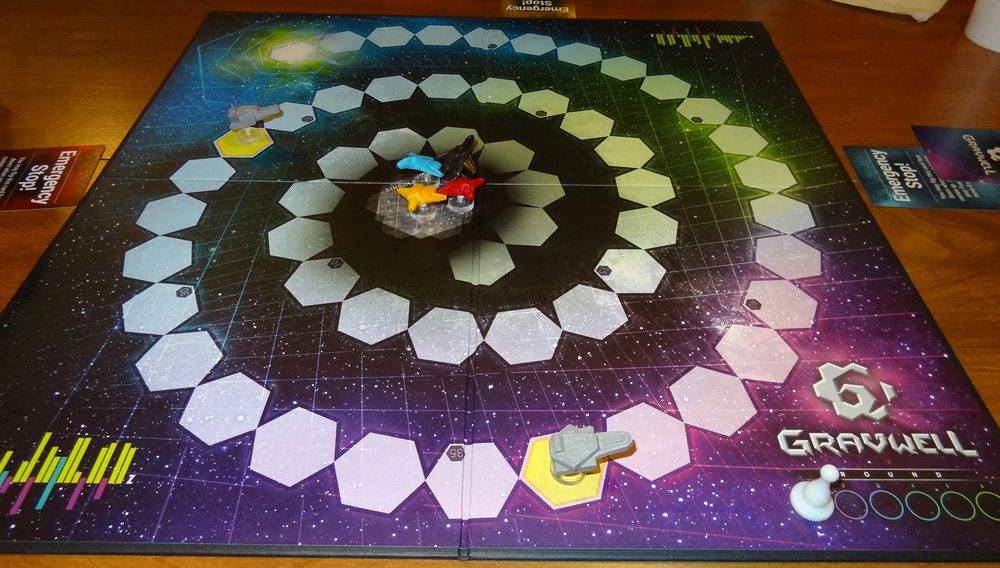
You’ll play six rounds, with each round having six turns. The Fuel Cards are shuffled, and you make three times as many stacks as there are players—each stack will have one face-down card and one face-up card. (Unused cards are set aside until the next round.) Then you take turns picking stacks to take until each player has taken three (giving them a total hand of six cards). The first round, you can go youngest to oldest or whatever, but in subsequent rounds you go from last place to first place.
Each player chooses a card from their hand, and then everyone reveals the chosen cards simultaneously. They’ll resolve in alphabetical order. You’ll move the number of spaces shown on the card, toward the nearest spaceship. Ships inside the Singularity don’t generate any gravity, so they don’t count. Purple Repulsor cards push you away from the nearest ship, and blue Tractor Beam cards pull everything toward you a number of spaces. Each space can only hold one ship, so if you would land on another ship exactly, you just keep moving in the same direction until you find an empty space.
If there are two ships equally close to you, then you look to see how many total ships are ahead or behind you, and then move in that direction (or away, in the case of the Repulsor). If there are somehow the same number ahead and behind, then you just stay put.
Once per round, you can use your Emergency Stop card to cancel your own card, and then your ship just stays put for that turn.
After all six turns have been played, you gather up all the Fuel Cards, shuffle them with the unused ones, and draft stacks again. You reset your Emergency Stop cards if used, and start again.
The game ends either after the sixth round or when a player manages to get all the way to (or past) the Warp Gate. If nobody escapes, the winner is the player who got closest to the end.
The Verdict
When I saw people playing Gravwell at Gen Con, I know there was usually a lot of laughter, and now I know why. Your success in the game often depends on how well you can predict your opponent’s movements. There are frequent setbacks when the ship you thought you would be moving toward is gone by the time your card resolves, and you end up flying backward at a rapid pace.
It’s also very hard to predict the outcome of the game until the end. After the first round, two players were far ahead, past the second derelict ship, while the other two (including myself) were barely out of the Singularity. By the second round, the positions had almost reversed. The trick is that if you’re up front, then everything is behind you, which means only a very few cards will keep you moving forward unless you let people catch up a little.
The effect is akin to traveling by rubber band—if you’re behind everyone, you can only go forward, and if you’re in the front, you get pulled back. The goal is to snap forward at just the right moment, when there’s enough momentum to get you all the way to the gate. But when you’re in the middle, you’re jockeying for position, trying to move when you’re a little closer to the ships ahead of you rather than behind you. Picking the right card is both a matter of deciding how quickly you want to move and how far. The letter A guarantees that you’ll move first before the board changes, but you only move 1 space. M has the biggest movement at 10, but it’s smack in the middle of the alphabet and it’s much harder to guess if your opponents are going before or after you.
The solo variant just has you playing against a randomly-controlled ship, and you try to escape in four rounds. It’s clever, but not nearly as satisfying as playing against other people who will laugh at you when you play Magnesium and fly yourself backward into the Singularity. There are a few other optional rules, like having all the stacks be face-up when you’re drafting cards, or limiting your Emergency Stop to once per game instead of per round. But the basic game has plenty of replay value even without throwing in the other rules.
All, in all, Gravwell is an extremely fun game that’ll really suck you in. It doesn’t take long to teach, setup is a snap, and you can play two or three times in a row in an hour once you know what you’re doing. Ask your local game store or check back online in January—Gravwell is definitely worth seeking out.
Disclosure: Cryptozoic provided a review copy of Gravwell.




